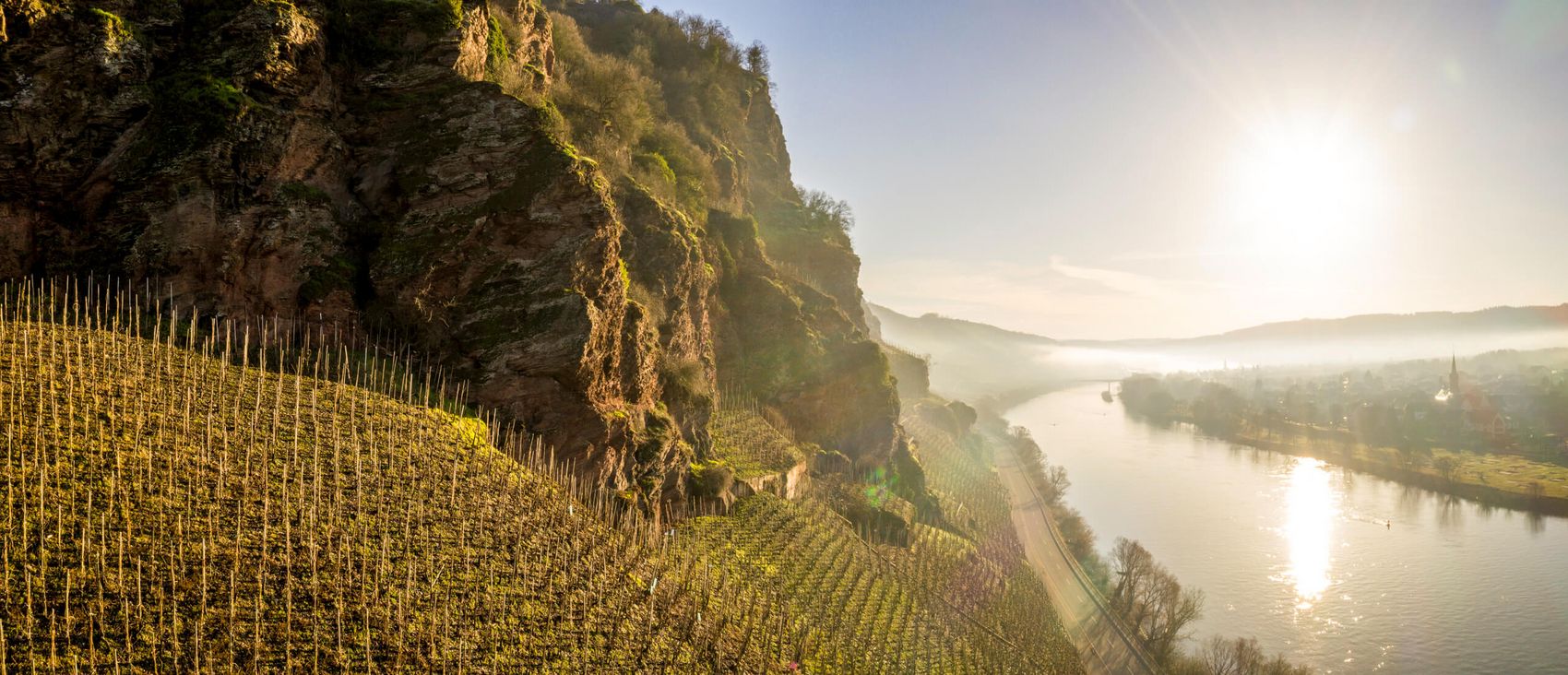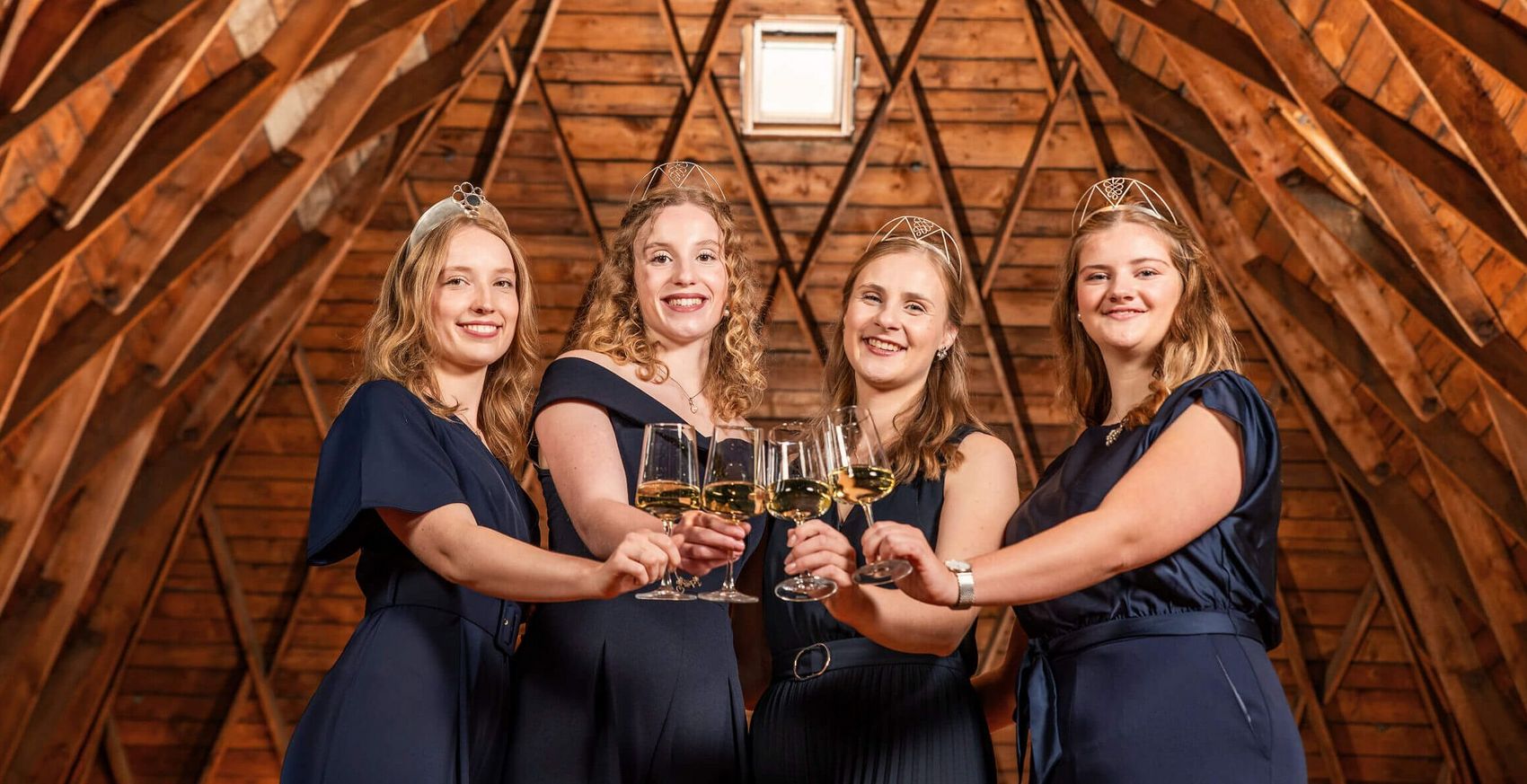On the steepest vineyards in Europe, in the oldest wine region in Germany, top-quality Rieslings of astonishing elegance and minerality grow on primeval slate rock. There have always been world-class wineries here at the Mosel. A young generation of highly trained winegrowers is now taking the helm and putting their own stamp on the winegrowing region.
Wine is history and tradition
The Mosel is Germany’s oldest wine region. The steep slopes of the river valleys are densely planted with vines and characterise this area more than any other wine-producing region in the world. The Mosel and its tributaries, the Saar and Ruwer, flow through a tradition-steeped cultural landscape where Celts and Romans cultivated their vines 2,000 years ago.
Wine is passion
3,000 winegrowers along the Mosel give their all every day to produce distinctive, world-class wines. They live their profession with passion and enthusiasm. A young generation of winegrowers has set out to put their own stamp on Riesling and Co.
Get to know the faces behind the wine!
Wine is landscape
The Mosel’s unique cultural landscape is characterised by its steep, sometimes world-famous, vineyards. The conservation of this landscape and its biologically diverse vineyard habitat is a matter close to the hearts of those of us living in the Mosel region.
It is not for nothing that the "Living Moselle Vineyards" initiative [Lebendige Moselweinberge] was founded in 2013, which brings together many activities relating to the vineyard ecosystem. Also worth visiting are the `Leuchtpunkte`, highlighted points of biological diversity in the area, which form a chain of characteristic destinations offering rich experiences and can be reached via the local hiking trails.
Wine is royal
Insider tips: The best excursion tips recommended by our wine ambassadors
The election of the Mosel wine queen goes back to a long tradition. A new wine queen has been crowned every year since 1949. Together with her princesses she represents the wine-growing region Mosel. They are modern ambassadors of the Mosel region who represent their homeland with great commitment. As true Mosel girls, they know the best places to visit at the Mosel - real insider excursion tips!
Since when grapevines have been cultivated in the Mosel area?
Winemakers have been pressing their grapes along the Mosel since antiquity. They arrived in the wake of Caesar’s legions, who had conquered the Mosel region in the Gallic Wars. Trier, the first city founded in the Germany we know today, became an imperial residence and metropolis – the demand for wine, a drink already favoured by the Celts and Romans, was correspondingly high. Therefore, the Mosel region offers you 2,000 years of wine culture.
How many vineyards are along the Mosel?
The wine region is divided into six districts according to wine law: Burg Cochem (known as “Terrace Mosel”, from Koblenz to Zell), Bernkastel (Middle Mosel from Briedel to Trier), Saar, Ruwer, Upper Mosel (the Mosel from Trier to the border of the federal states of Rhineland-Palatinate and Saarland) and Moseltor (Mosel area in Saarland to the German-French state border). In terms of landscape, Upper Mosel and Moseltor form the Southern Wine Mosel region. These areas are subdivided into 19 major sites as well as around 520 individual ones. It’s not so easy keeping track of them all...
What percentage of the vineyards are located on steep slopes?
Around 40 percent of vineyards in Mosel, Saar and Ruwer regions are located on the steep slopes of river valleys. Vineyards with a gradient of more than 30 percent are considered steep slopes. With approx. 3,500 ha of vineyards on steep slopes, the Mosel region is the largest steep-slope wine region in the world.
What is the steepest vineyard in the world be called?
The steepest vineyard in the world is located along the Mosel, between Bremm and Ediger-Eller, and has a gradient of up to 68 degrees. Do you feel like climbing the Mount Everest of Mosel vineyards? The Calmont via ferrata takes you on narrow paths, via ladders and steel cables, along rock edges through the vineyard and rewards you with breathtaking views of the Mosel.
Which grape variety is the absolute favourite of Mosel winemakers?
White wine is dominant in the Mosel wine region. More than 91 percent of vineyard coverage is planted with white grape varieties. With 62 percent, Riesling is the most important grape variety along the Mosel, Saar and Ruwer. In the Saar and Ruwer Valley areas, the percentage is significantly higher than in the region as a whole, at around 83 and 88 percent respectively. The “queen of white vines” is particularly well suited for cultivation on the steep slopes of the Mosel, Saar and Ruwer river valleys. Because of the grape's long ripening phase, it produces mineral, delicately fruity, elegant wines that age well. Müller-Thurgau, Pinot Blanc and Pinot Noir as well as the Mosel speciality Elbling are also important regional grape varieties. Have you found your personal favourite among grape varieties? A wine tasting allows you to to get to know the diverse variety of Mosel wines.
What German quality levels with predicate are distinguished in wine?
The first level of so-called “Prädikat” wines is Kabinett, which is followed by Spätlese (late harvest) and Auslese (select harvest). For Kabinett wines, ripe grapes are harvested earlier with less must weight, meaning that this category is characterised by wines with low alcohol content and a fresh, acidic structure. Spätlese wines are produced from very ripe grapes; Auslese wines from individually “selected” grapes. Beerenauslese wines (berry select harvest) and Trockenbeerenauslese (dry berry select harvest) wines are more rare and are made from dehydrated grapes. Noble rot or botrytis plays an important role here as this fungus befalls grapes in autumn and causes them to dehydrate. The level of sweetness and other characteristics are concentrated. Eiswein (ice wine) is pressed from grapes frozen on the vine so that the grapes’ water content is reduced.
Why do Mosel wines taste so mineralised?
The answer lies in the soil conditions, which have a particular influence on Mosel wine. Along the Mosel, slate dominates. Slate soil stores heat during the day and releases it again at night. Fine weathered slate constantly disintegrates and provides the soil with minerals such as potassium, calcium and magnesium. Vine roots transport these minerals to the fruit. This is why wines from the slate vineyards along the Mosel are particularly spicy and mineral in taste.
What does PIWI mean?
The abbreviation PIWI stands for fungus-resistant grape varieties, i.e. grape varieties that are immune to diseases such as mildew. They combine good flavour with high resistance and help winegrowers to protect our environment.
Today, there are many different Piwi varieties that produce a variety of wines with individual characters and unique flavour profiles. While Regent is probably the best-known Piwi grape variety, Cabernet Blanc, Solaris, Souvignier Gris, Muscaris and Sauvignac are also becoming increasingly important, including on the Mosel! The journey of discovery is exciting and offers new flavour experiences.
How do the bubbles get into the sparkling wine?
Sparkling wine is produced when a secondary fermentation takes place in the wine. For this to happen, yeast is added to the base wine, which converts the residual sugar in the wine into alcohol. Carbonic acid is also released and this remains contained in the wine, producing the fine bubbles that give sparkling wine its character.
The sparkling wine must be aged on the lees for a minimum of nine months, for Crémant this is set at twelve months. To remove the lees from the natural sparkling wine, the bottles are riddled in special riddle racks. This allows the lees, which have previously settled on the wall of the lying bottle, to move into the bottle neck. To remove the sediment, the neck of the bottle is frozen. When the crown cork is removed, the ice plug containing the sediment is ejected due to the pressure of the carbonic acid in the bottle. This process is called disgorgement. The dosage that follows, i.e. the addition of a sweet wine to replace the liquid lost during disgorgement, serves to define the flavour of the finished sparkling wine.
Do you know your personal favourite wine?
YES? Then we're really happy that you've already found your favourite.
NO? Then what are you still waiting for? Immerse yourself in the wonderful world of Mosel wine! You’re certain to find a perfect match here – a wine to fall in love with. This could be at a wine tasting in one of our vinotheks or directly at the source, at one of our wineries. At a winery, you get to know the winemaker personally and learn first-hand how much work goes into a bottle of wine. Or, perhaps, you’ll discover your favourite over dinner at a restaurantor at one of our wine events. The opportunities are abundant here in the Mosel region and when your chosen wine proves itself back at home and makes you just as happy as it did on your Mosel holiday, then you’ll know you've found your favourite!
What is the most beautiful part of the Mosel?
The most beautiful thing about the Mosel is – it doesn’t have just one most beautiful place, but many!
Whether you're enjoying the panoramic view over the vineyards near Bremm at the Calmont – the steepest vineyard in Europe – strolling through the romantic half-timbered lanes of Bernkastel-Kues, or going on a shopping tour in Trier and Koblenz – every part of the Mosel has its own unique charm.
But those who truly love the Mosel will discover its heart in the vineyards. It's most beautiful where steep vine-covered slopes curve gently along the river and the scent of Riesling lingers in the air.
In short: the Mosel is at its most beautiful in the vineyards – where nature, craftsmanship, and indulgence come together to form a truly unique landscape.

